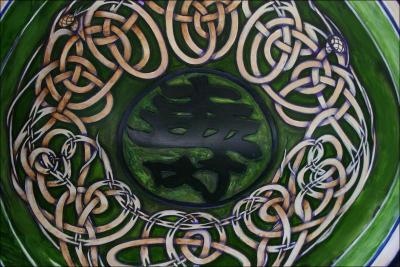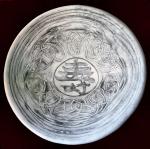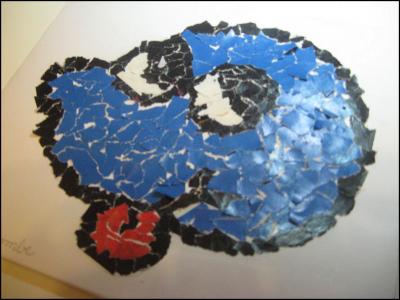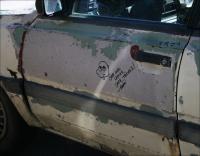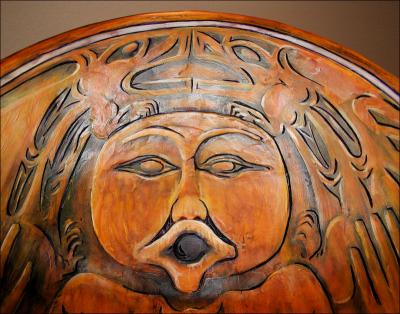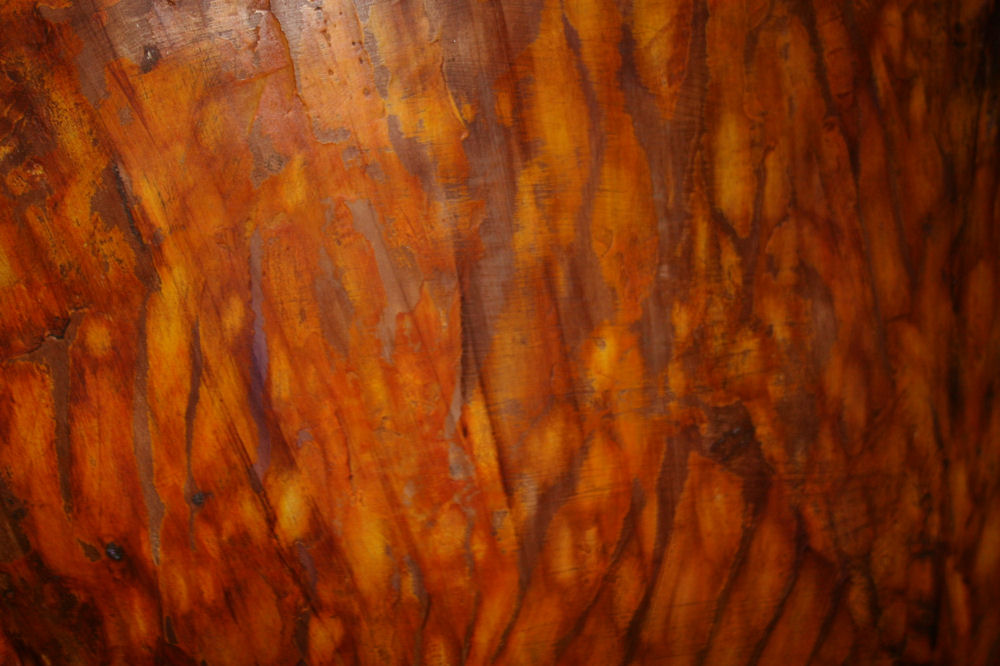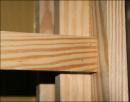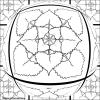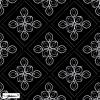design
« Previous Entries Next Entries »The Tree Of Life chair
Saturday, April 18th, 2009
April 18th, above: still in an extremely rough state, and still deciding about which colors to use and how. There must be much more plaster on the Salish chair, because this one is not carving as well. Only the Shou symbol will stand out carved..all else will be implied. Blue, purple and green are the new black! Actually that’s the old impressionist trick of course, but I also rarely use black if those 3 will do – they are much livelier and more interesting than flat black. The Yin-Yang/Aboriginal legend snakes have been eliminated because working them in color-wise was going to be a problem. The Celtic design was getting lost in too much else around it. I am anxious to find another chair because I really want to do one with Australian-inspired motifs and colors.
Post-dated note: Unfortunately, there is not enough room to show this for the premier of the Trees show in Raleigh. I’m mostly relieved that there is extra time in my schedule now for preparations, but this chair now needs to be set aside in light of the other priorities.
April 14th: 29H x 29W x 29D inches vintage chair, canvas strips, layers of sanded plaster.
The design incorporates a few esoteric concepts common to many world cultures: Overall is the idea of the Tree of Life and the theory of As above, So below, represented by branches and roots. Symbolic of longevity along with the pine tree, and central to the design is the Japanese character, Shou. The branches and roots of the pine tree are interwoven in the classic Celtic style, inspired by designs in the Book of Kells, gospel manuscripts that were illustrated by Irish monks around the year 800 A.D., common era. Two snakes drawn in the Yin-Yang placement represent Australian Aboriginal legends; the Rainbow Snake is their most important sacred symbol, believed to be the creator of all things. Christian biblical literature it is the snake who gives the apple from the Tree of Knowledge to Eve. There are more, but the rest you may like to discover yourself!
There is still plenty of intricate work to do with the roots – this’ll be fun! Drawing freehand is much better than casting the original drawing on with light and tracing it because each time it’s drawn, first with graphite, then marker, then many layers of paint, I become more familiar with the lines and the final outline will be steady and clean.
 April 7, 2009: While studying some of the previous paintings that are still in progress, I sketched out my version of The Tree of Life, a preliminary drawing for the fourth refurbished vintage chair, and have also been layering and sanding the plaster in preparation for it. Colors planned are black, off-white and greens. The other chairs in this series are shown here.
April 7, 2009: While studying some of the previous paintings that are still in progress, I sketched out my version of The Tree of Life, a preliminary drawing for the fourth refurbished vintage chair, and have also been layering and sanding the plaster in preparation for it. Colors planned are black, off-white and greens. The other chairs in this series are shown here.
Encaustic – painting with beeswax
Friday, January 16th, 2009
Windy Maple Leaves, 8H x 10W x 2D inches encaustics
1) design inspired by Flamboyant Tree Seed Pods, white beeswax inlay on black, and 2) using a print of an old painting Dahlias as a base, techniques were more spontaneous, each 10H x 8W x 2D inches encaustics
Encaustic Artist Deanna Wood offers her studio space and supplies to her students on days when she’ll be there working. It’s a bargain for $30 per day so I went yesterday and finished the two pieces above. Painting with wax is a messy process, and Deanna’s studio is all set up for it, so it’s a perfect arrangement for artists who work primarily in other mediums, who don’t yet have their own supplies and wish to continue exploring encaustics. BYOS – Bring your own surface!
With a FAQ page on her website, Deanna outlines a brief history about encaustics and herself. Her most recent solo exhibition displays a portion of the extensive amount of encaustic works created around the theme of tornadoes. Including a few multi-media pieces as well, the show runs January 10th – February 29th, 2009 at the Leslie Powell Foundation and Gallery in Lawton, Oklahoma.
Sumac Bushes director’s chair started
Tuesday, January 6th, 2009
Sumac Bushes director’s chair started. Back and seat of 47H x 22W x 16D inches acrylics on canvas, will be varnished. Up-cycled tall wood director’s chair, work in progress, functional art. The wood will be painted a cherry color.
The Monte Files
Saturday, January 3rd, 2009
Post-dated January 11th, my niece Camille created this.
Post-dated January 28th, my son Adrian created this with his new industrial emboidery machine…good luck with your new biz Adrian!
 Who or what is Monte? (“Mon-tee”)
Who or what is Monte? (“Mon-tee”)
Borne out of inattentiveness in a grade six science class, I drew Monte everywhere on my friends’ notebooks, on everything I owned, even painted him on the back window of a friend’s car during the late ’70’s, which I have no photo of, unfortunately.  Monte has managed to come back to life every few years since then in some form or another. The cartoon head is originally blue and drawn along with different hand gestures, but the basic shape can morph into any figure simply by changing the eyes, shape of the head, adding ears or a nose or a suitable body.
Monte has managed to come back to life every few years since then in some form or another. The cartoon head is originally blue and drawn along with different hand gestures, but the basic shape can morph into any figure simply by changing the eyes, shape of the head, adding ears or a nose or a suitable body.
 The Monte Files were listed on my very first website (2003) with the invitation for you, whoever and wherever you are, despite your age or drawing capabilities, to send in your version of Monte or a character inspired by him, and add it to the collection. The Monte Files are back, listed as a permanent page on this website and the invitation stands.
The Monte Files were listed on my very first website (2003) with the invitation for you, whoever and wherever you are, despite your age or drawing capabilities, to send in your version of Monte or a character inspired by him, and add it to the collection. The Monte Files are back, listed as a permanent page on this website and the invitation stands. 
Your character doesn’t even have to resemble Monte at all, and can be created using whatever media you wish. Scan him, trace him, shred him to bits then reassemble him, make a collage with magazine clippings, write a quip or add hand gestures…no rules except be kind and have fun with it; Monte’s up for anything….
 Children, adults, artists or not, or if you have a website of your own that you’d like to promote in The Monte Files then send a jpeg image of your version of Monte, or a character inspired by him, along with any information you wish to share to nikki_coulombe@hotmail.com. I have no knowledge of how to, nor a desire to use your information in an unethical way, so you have no worries about that.
Children, adults, artists or not, or if you have a website of your own that you’d like to promote in The Monte Files then send a jpeg image of your version of Monte, or a character inspired by him, along with any information you wish to share to nikki_coulombe@hotmail.com. I have no knowledge of how to, nor a desire to use your information in an unethical way, so you have no worries about that.
When we were in California recently we met some ladies at a rest stop who were driving to New York City from Alaska in a beat up old car. Friends, and people they met along the way signed their car. Monte travels!
Salish Spindle Whorl Chair finished
Saturday, December 20th, 2008
 About the chairs: Art on Art on Art – A Tribute to Creativity
About the chairs: Art on Art on Art – A Tribute to Creativity
Each functional, comfortable 29 x 29 x 29 inch replica of ancient Art or artifact re-utilizes vintage plastic lawn chairs that were considered Art during the 1960’s. The original structures, damaged or unusable were refurbished by a process of weaving canvas strips along with white glue paper-mache style over the entire plastic top and bottom, and multiple layers of drywall compound sanded in between coats. Designs are drawn with graphite, painted with acrylics and a few coats of varnish for durability, then waxed to finish and enrich the colors. Two more Solaire chairs and other styles of chairs are in various stages of completion yet to be embellished with historic Art themes from other cultures. Other styles of chairs are also in progress.
 The skeletal structure of these chairs, called Solaire chairs, were manufactured during the 1960s and 1980s. Art in their own day, these particular ones were unusable; in poor condition they were bound for the landfill sight. Originals designed by Fabiano and Panzini, a French Canadian team, the Solaire chairs are now collectors items, some selling for $500.
The skeletal structure of these chairs, called Solaire chairs, were manufactured during the 1960s and 1980s. Art in their own day, these particular ones were unusable; in poor condition they were bound for the landfill sight. Originals designed by Fabiano and Panzini, a French Canadian team, the Solaire chairs are now collectors items, some selling for $500.
The first chair to be up-cycled was a large replica of a Mayan bowl. The Mayan culture (Mexico, Guatemala, Belize and parts of Honduras, 900 B.C. – 900 A.D. Common Era) developed a very complex written language using pictographs. Many of these were facial expressions and hand gestures. The bowl displays the birth of the Maize God, and along the top edge the name of the bowl’s owner is written, as well as possibly what it was used for.
Salish Carved Wood Whorl
 Whorls are weights that stabilize used for spinning yarn. The yarn in this case would have been wound just above the whorl. Spinning yarn and weaving fabric are some of humankind’s oldest technology. Left: example of a spindle with whorl, Eve Spinning Illuminated Manuscript c. 1170 A.D.
Whorls are weights that stabilize used for spinning yarn. The yarn in this case would have been wound just above the whorl. Spinning yarn and weaving fabric are some of humankind’s oldest technology. Left: example of a spindle with whorl, Eve Spinning Illuminated Manuscript c. 1170 A.D.
Historically everywhere wood has been used for tools, utensils and everyday items, they were often carved. The original spindle whorl that was the inspiration for this chair was used by a Salish Northwest Pacific coast community living south and east of Vancouver Island. Here a central human figure holds two otters. A Kwakiutl (also living in Vancouver Island territory) prayer to a Cedar tree prayer was very much a part of the inspiration for this chair. It reads: “Look at me friend! I come to ask you for your dress, since there is nothing you cannot be used for. I come to beg you for this, Long-life maker”.
December 18th: Finishing details, further definition with acrylics and two coats of varnish, waxed. Decided against the decoupage of the Kwakiutl prayer to a Cedar tree because it does not look as good as hoped. December 16th: Carved the plaster in areas then inlaying purple for contrast rather than black. Purple glazes also make yellows much richer.
The back and under-side of the chair is painted to look carved. The undercoat of yellows shines through succeeding layers, and carved wood textures are created with varnish leaving raised brushstrokes, and am trying whatever else I can think of to make it look like wood! More modeling with plaster and light sanding, then redrawing with graphite, and the design is continually adjusted.
New chair started: Salish Wooden Whorl
Sunday, December 14th, 2008
This functional replica of a Salish Carved Wood Whorl re-utilizes a 1960’s plastic lawn chair, 29H x 29W x 29D inches that was considered Art in its own day. The refurbished chair has woven canvas strips and white glue applied paper-mache style over the entire plastic top and bottom. Multiple layers of wall plaster are sanded in between coats. The design is sketched with graphite then painted with acrylics, and drawing is continually adjusted as layering of materials continues.This is the second chair of four in the historic Art-themed series. The other two chairs are in the earlier stages of progress.
Behind The Scenes
Friday, December 5th, 2008
The brush swishing against the taut canvas makes a music of its own.. gentle drumming sounds. Priming the canvas is a soothing task. It’s purely a sight thing, straightforward, doesn’t need study or thought. There are so many small efforts toward the creation of a painting. The process of defining a scene on the front is probably 40% of the entire amount of work considered.
We’re result-oriented, but details matter: the materials underneath the paint, the quality of paint, to frame or not to frame, tidiness, cleanliness back and front, hanging apparatus…these are just a few of the details behind my scenes.
Going for the magic every hour
Friday, August 15th, 2008
Magic Hour finished (Gitxsan Totem Pole, Thunderbird Park, Victoria, BC Canada), 60H x 40W x 3D inches acrylics on canvas, sturdy home-built stretcher frame, wrapped sides painted, narrow trim frame. Here is an earlier post with information about this totem pole.
 Great moments in painting are addictive, when so completely immersed in the work that time becomes non-existent… The Zone! I’ve had a good week with this one, partly because of getting past the habit of trying to control the outcome. Things happen in every painting that are not planned, and the endless choices are part of the fun.
Great moments in painting are addictive, when so completely immersed in the work that time becomes non-existent… The Zone! I’ve had a good week with this one, partly because of getting past the habit of trying to control the outcome. Things happen in every painting that are not planned, and the endless choices are part of the fun.
Painting is considered to be a two-dimensional undertaking, but it’s so much more. While lost in the work process, all the dimensions of the subject are explored, including the deeper dimensions of ourselves. While painting we discover our convictions and the means to ask how far we are willing to go to stand up for them.
Work every day is about continually reevaluating decisions, taking responsibility for choices made, being honest about mistakes, shortcomings and limitations of media and self, and digging deep to find compromise between technical and intuitive solutions. It’s about control of all those elements, combined with easing up on trying to control too much. All this and more translates onto a flat surface as we hope to give the illusion of depth…if that isn’t magic, I don’t know what is!
Post-dated Note: When choosing this totem pole that is erected in Thunderbird Park at the RBC Museum in Victoria, I didn’t realize that it’s the same one that Emily Carr painted in 1928. More magic! Here is a link to more information about this totem and the Gitxsan Poles moved from Gitanyow (formerly Kitwankool) B.C.
A word here about artists’ representation of First nations or any other cultural/historic works: subjects are painted with the greatest honor and respect, with purpose to study and draw interest to the importance of appreciating our multi-cultural world and the unique characteristics of each and every culture. This is what artists do. Our differences as cultures are connected across time and place, as there are many common traits and themes expressed through Art everywhere.
Robert Genn and readers of The Painters’ Keys have some very interesting comments all around the board about this topic.
Design Inspiration
Sunday, July 27th, 2008
My Dad recently gave me a few Art books of his. I remember browsing through them when I was younger. He always left his books out laying around on the tables, intending to plant the “drawing seed” in me, and it worked. One of the books Is about the art of M. C. Escher. What a mind! You can’t help but flip through pages of art like that and not be inspired.
 This week I was also organizing my photos of leaves, seeds, and bark that I took specifically because of their outstanding design. Looking through the books plus my photos compelled me draw a few designs I’ve had in mind for a couple of years. I may paint some large one-of-a-kind cushion covers using a few of the best.
This week I was also organizing my photos of leaves, seeds, and bark that I took specifically because of their outstanding design. Looking through the books plus my photos compelled me draw a few designs I’ve had in mind for a couple of years. I may paint some large one-of-a-kind cushion covers using a few of the best.
 There is no substitute for a good old fashioned pencil, but it’s sure fun to play with the Paint Shop Pro effects, cut and paste, repeat patterns. The drawing combined with computer play have me appreciating Escher’s work so much more. He did not use computers at all.
There is no substitute for a good old fashioned pencil, but it’s sure fun to play with the Paint Shop Pro effects, cut and paste, repeat patterns. The drawing combined with computer play have me appreciating Escher’s work so much more. He did not use computers at all.
New marketing strategies
Sunday, May 11th, 2008
Grackle Party, Dallas Texas, 11H x 9W inches graphite and colored pencils, white double mat, white frame with crackle finish
In her Wed. April 30th blog post, my friend Chris Bolmeier writes about an older painting she revitalized, and in this case it improved dramatically. Surprise 2 supports what I wrote in yesterday’s post: many paintings need a period of rest before we know how to solve them. In any Artist’s home/studio there are at least ten or so paintings hanging around or put away in unfinished states. If it isn’t sold immediately, chances are 50/50 it will continue to change as we attempt to improve it until we know it’s truly finished.
Chris is trying new marketing strategies, and offering anyone who sells her work a 20% cut. A little out of the ordinary to show and offer another artist’s work for sale on my own website, but this is a brilliant idea she has, and I don’t mind trying to help promote her work. Good Luck with your sales, Chris!
« Previous Entries Next Entries »

